Before I go into the best national heritage Hotels of Spain, I thought it might be interesting to know a little background on this wonderful initiative. It was in 1910 that the government entrusted Marqués de la Vega Inclán the project of creating a hotel network, practically non-existent in the country at the time, which would provide accommodation for tourists and improve Spain’s international image.
In 1926, continuing this Project and from the office of the Royal Tourism Commission created in 1911, De la Vega Inclán impelled the construction of a hotel in the Gredos Mountains, which would open up the wonders of this landscape to tourism.
The idea excited King Alfonso XIII, who chose the location personally. Work began in August of this same year and was completed on the 9th of October 1928 with its inauguration by the King himself. This was to become the first establishment of the subsequent network of Paradores de España, the Parador de Gredos.
With this first establishment inaugurated, the ‘Board of Paradores and Inns of Spain’ was drawn up and efforts were focussed on perfecting the original idea and making use of chosen historical and artistic monuments and areas of great natural beauty to establish new Paradores.
In the favourable climate of the twenties, the results of the first administration and the imminent Latin American Exposition reinforced the project and inspired the construction of new Paradores, now in monumental buildings, such as those inaugurated in Oropesa (1930), Úbeda (1930), Ciudad Rodrigo (1931) and Mérida (1933), among others. At the same time, the first lodging houses that were being integrated into the network would also open to the public, such as Manzanares (1932), Bailén (1933) and Benicarló (1935).
With the passing of the years, Paradores continued to spread out over the entire country. This was also a period marked by the development of infrastructures such as roads, railways, airports, ports…
The Civil War, naturally, meant not just stagnation but a slump for tourism. Some of the infrastructures comprising the network were damaged or used as hospitals, but once the conflict was over, the idea was consolidated and a new impulse was produced with the restoration and reopening of the existing Paradores.
During the period following the war, Paradores were created with diverse ends, as in the case of the Parador de Andujar, as well as others whose objective was to promote the country’s tourist attractions. The conversion of the San Francisco de Granada Convent, located in the heart of the site of the Alhambra, one of today’s most attractive Paradores, took place during these years (1945). The same occurred in other tourism settings, such as Santillana del Mar (1946), Malaga, with the Parador de Gibralfaro (1948), and Pontevedra (1955).
Nevertheless, the greatest expansion was produced during the decade of the sixties, coinciding with the significant tourism development that the country experienced. During these years the network of Paradores went from 40 to 83 establishments. Among others, the following were opened: Córdoba (1960), Cañadas del Teide (1960), Jaén (1965), Guadalupe (1965), Nerja (1965), Aiguablava (1966), Ávila (1966), Olite (1966), El Saler (1966), Vielha (1966), Gijón (1967), Zafra (1968), Hondarribia (1968) and Toledo (1968).
The period of the Spanish transition brought about the change in the ownership of the General Management of Paradores, and more importantly, its administrative department. A broad restructuring was implemented, closing some obsolete installations or those very far of the traditional routes and as such producing heavy losses, and the operating criteria were revised in order to improve profitability. Over these years Paradores provided the setting for acts as important as the elaboration of the draft of the Constitution in the Parador de Gredos (1978), the signing of the draft of the Statute of Catalonia in the Parador de Vic (1978), and the Statute of Autonomy for Andalusia in Carmona (1980). And the inaugurations did not cease. Among them were some as outstanding as Sigüenza (1976), Carmona (1976), Cardona (1976), Tortosa (1976), Almagro (1977), Seu d’Urgell (1977) and Segovia (1979).
During the eighties, a number of hotels from the public chain Entursa became part of the Paradores network. Among them, establishments as emblematic as the Hostal de Reyes Católicos (Santiago), the Hostal de San Marcos (León) and the Hotel La Muralla (Ceuta). Both Santiago and León have maintained their five stars deluxe category throughout the years. At the same time Salamanca (1981), El Hierro (1981), Chinchón (1982), Trujillo (1984) and Cáceres (1989) were opened.
With the arrival of the nineties, Paradores experienced a fundamental change. On the 18th of January 1991 the corporation, ‘Paradores de Turismo de España, S.A.’ was established. The objective was to make the hotel chain a profitable company which depended exclusively on its own profits for the maintenance and operation of the network. At this time its activity consisted of the management of 85 establishments and two lodging houses located on the Spanish mainland, the Canary Islands, Ceuta and Melilla.
Paradores has combined tradition with innovation and developed new strategic policies: a clear commitment to environmentally-friendly policies, a strong investment in the renovation of the network, the development of R&D initiatives, the implementation of new technologies and the promotion of quality as the main premise of the hotel service offered by the chain.
The thirty hotel beds with which Paradores started, with the inauguration of the first establishment in the Gredos Mountains in 1928, have now reached over 10,000 and the number of establishments has reached a total of 97. Many of these are located in historical buildings such as convents, monasteries, castles and palaces. The rest, often located in monumental settings or in the very heart of nature, exhibit a regional or modern architecture.
Currently, more than 3.500 professionals work for Paradores and the establishments have an average of 63 rooms, a size which allows for more personalised attention with a higher degree of quality in the services offered to guests.
With establishments in all of the autonomous communities (with the exception of the Balearic Islands) Paradores de Turismo is the leading hotel chain in cultural and nature tourism. As such, in addition to having establishments in nine cities declared World Heritage Sites, more than half of the Paradores in the network are found in monumental settings and many others allow people to lodge in national parks and the most interesting natural areas of the country.
A corporation with just one shareholder, the Spanish state, Paradores de Turismo is also an instrument of the government’s tourism policy, as well as a leading company in the Spanish tourism sector.
TOP 10 Paradores selected by travellers from around the world :
1. PARADOR DOS REIS CATÓLICOS – Santiago de Compostela *****
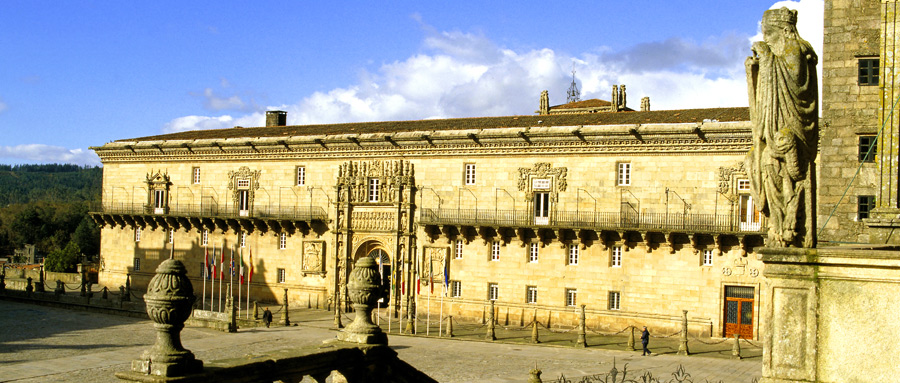
Combining history, art and tradition, the goal of pilgrims and the emblem of St. James, the Hostal dos Reis Católicos, in the Plaza do Obradoiro, forms together with the cathedral one of the world’s most remarkable, and most visited, urban settings. The Hostal, which first saw life as a Royal Hospital in 1499 to house the many pilgrims arriving in Santiago, today still invites the traveller to enjoy this universal and fascinating city.
Considered the oldest hotel in the world, it is also one of the most luxurious and beautiful. It has four extremely beautiful cloisters, elegant public rooms, spectacular bedrooms and a luxurious dining room offering Galician style fish and meats and the classic apple pies and crème Brulee.
2. PARADOR SANTO ESTEVO – Ribeira Sacra ****
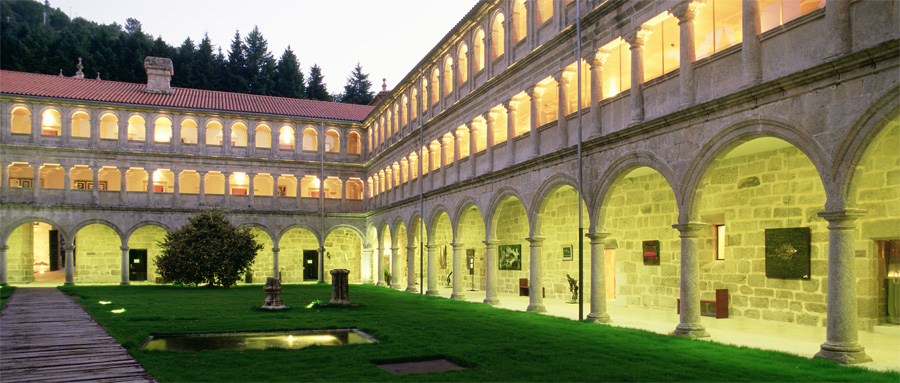
This Benedictine monastery in the middle of the Ribeira Sacra, an area of outstanding natural beauty where the rivers Miño and Sil meet, is one of Galicia’s monastic centres and now a holiday highlight. The existence of the Monastery has been proven in the 10th century, although its origins appear to be in the 6th and 7th centuries. In the monastery, styles range from Romanesque to Baroque, with three remarkable cloisters (Romanesque, Gothic and Renaissance). The building was declared a Historic and Artistic Monument in 1923.
The Hotel has a total of 77 rooms distributed around three cloisters of different styles and periods. The rooms are particularly interesting as they are all different, some with impressive views over the landscape and the valleys of the river Sil. The Hotel has a restaurant with terrace by the chestnut forest, a café with terrace in the entrance cloister, lounges and beautiful gardens.
3. PARADOR DE ALCALÁ DE HENARES – Madrid ****
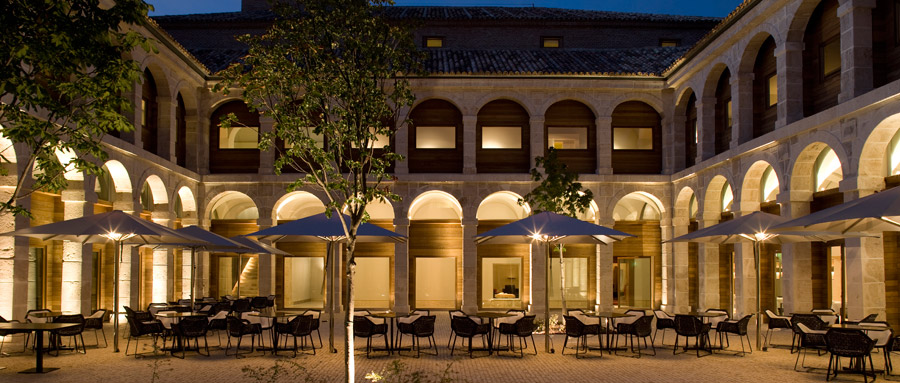
This newly opened hotel is located in Alcalá de Henares, Madrid, only 26 km from the capital city and 20 km away from Barajas International Airport and IFEMA. It has 128 guestrooms. Parador de Alcalá de Henares is housed in a magnificent seventeenth-century building, the former Santo Tomás Dominican Convent and School. It is one of the city’s landmarks along with Hostería del Estudiante, in the former Minor School of San Jerónimo, founded by Cardinal Cisneros in 1510 and overlooking the beautiful Patio Trilingüe at the University of Alcalá de Henares. These monuments form a complex that was designated by UNESCO as a World Heritage site. Around the cloisters, at the Santo Tomás School-Convent, there are the restaurant, the bar, the breakfast room, the guests’ lounge, and the night bar. There is also a restaurant in Hostería del Estudiante, which serves a wide range of courses, including Cervantine food and the well-known traditional “costradas”. The Parador has a swimming pool, which is open only in the summer. All in all, it is a wise combination of tradition and avant-garde, creating a space where you can relax or hold successful business meetings in a comfortable place living up to the high-quality standards of Paradores.
4. PARADOR DE OROPESA – Costa Azahar ****
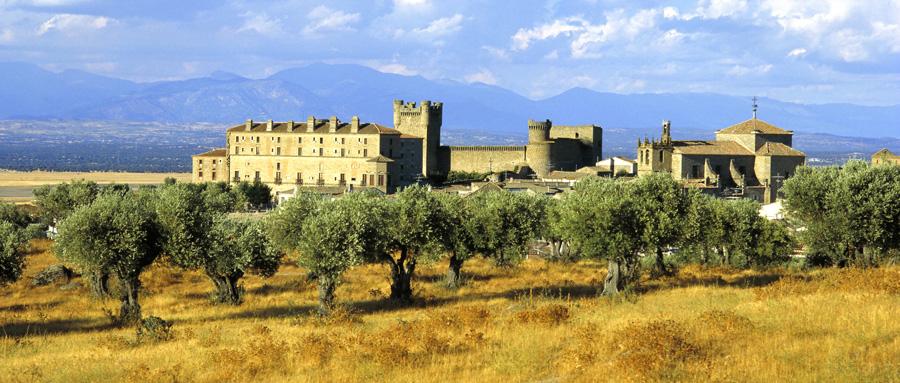
The stately home of the Álvarez de Toledo, Counts of Oropesa, once the home of soldiers, clergy and noblemen, enjoys exceptional views of the Sierra de Gredos. The historic value of the Torre del Homenaje, a tower attached to the Parador, the columns of the courtyard, and the pool with outstanding views over the plains of Campo Arañuelo, make up a very attractive hotel.
The interior is dominated by lamps, chests and curtains, with large, bright rooms, lounges and workspaces. Game and seasonal produce are features of Oropesa, where the cookery of Toledo offers lamb, roast kid and other specialities such as Migas del Arañuelo, a bread-based dish, and confit of partridge.
5. PARADOR AIGUABLAVA - Costa Brava ****
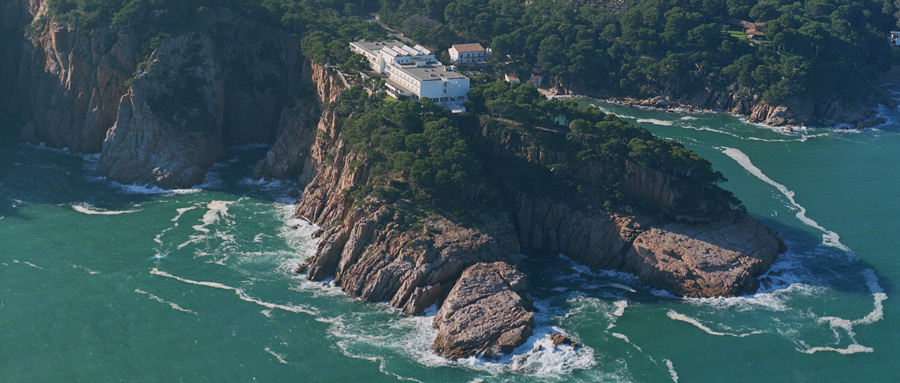
The Parador de Aiguablava is situated in the unique Punta D'es Muts enclave, surrounded by pine trees and overlooking the sea. Here guests can enjoy beautiful beaches, coves and unspoilt landscapes. It is an ideal location for sports and outdoor activities, as well as relaxing walks through picturesque green settings.
Under the distinctive light of the Mediterranean, the hotel provides its guests with a high level of comfort and a range of services both for individual guests and business conferences. There is a gym, swimming pool and sauna, as well as rooms with spectacular views overlooking the sea.
Costal influence is also reflected in the ‘ampurdanesa’ cuisine, whose typical dishes include sea urchins, baked snails and chicken and lobster stew. During the summer, dishes can be sampled on the beach alongside the restaurant.
The Parador has its own restaurant, ‘Mar i Vent’ which is separate from the hotel located in the neighbouring cove overlooking the Mediterranean Sea.
6.PARADOR DE CANGAS DE ONÍS – Picos de Europa ****
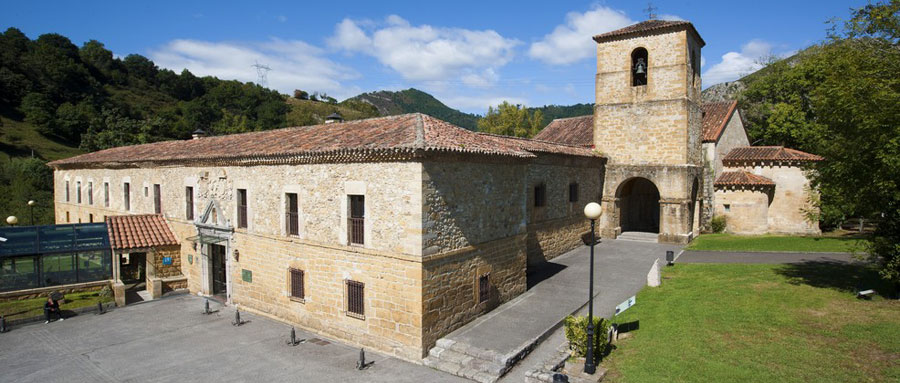
Tradition has it that it was built by Rey Alfonso I, ‘The Catholic’, on February 21st 746, with excavations carried out before conversion work started on the building for the Parador supporting the idea. The present monastery was founded on the site and run by the Order of San Benito until the 1835 sale of Church lands. Two rooms displaying archaeological remains found during refurbishment work, especially ceramics, bear witness to its distant past.
The Monastery was declared a National Monument in 1907 with a new wing added using matching building materials to match the original. Set on the green banks of the River Sella, this jewel is reflected in the waters below.
The magnificent Picos de Europa setting frames the backdrop. The modern and comfortable facilities at the Hotel make it the ideal spot to discover the wondrous Asturian landscape, enjoy local colour at celebrations and the ancestral folklore, as well as savour the best most genuine dishes from the rich local cuisine.
7. PARADOR DE CARDONA – Catalunya ****
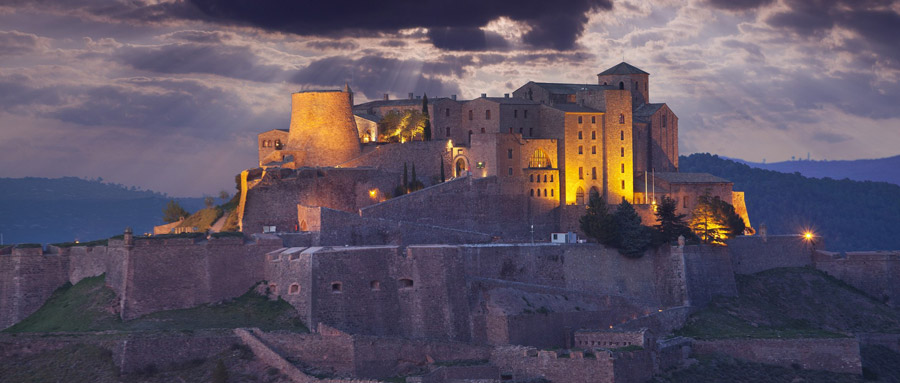
The Hotel is located on a headland in a 9th century fortified enclosure, alongside the 11th century Minyona tower and an 11th-century church with characteristic features from the surrounding Catalan Romanesque. Its location provides exceptional panoramic views over the city and the fertile lands bathed by the River Cardoner.
Some of the hotel rooms have charming canopy beds. Pits, towers, walls and gothic features come together with predominantly comfortable décor and Catalan-inspired mediaeval furnishings.
Catalan cuisine is served in the dining room including aubergine terrine with pig’s trotters, selections of sausages and especially barbecue dishes with the braised lamb shoulder a highlight.
8. PARADOR DE PLASENCIA – Caceres ****
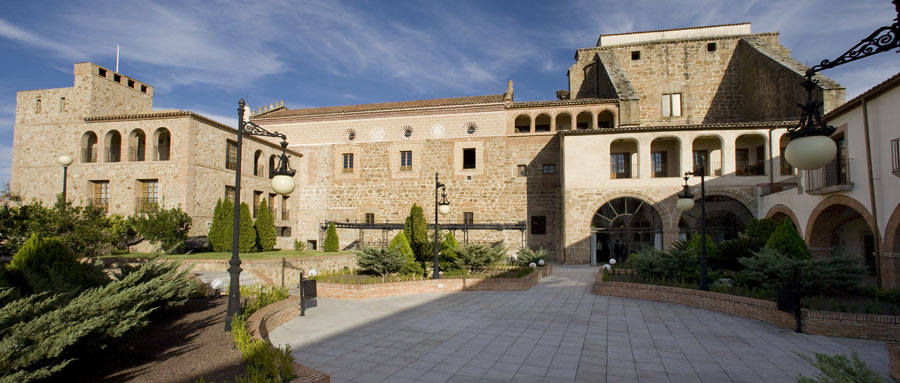
The hotel is in the former convent of Sto. Domingo, founded by the Zúñiga family in the mid 15th century, in the Gothic style inside and in part of the exterior.
Strategically located in the historic centre of Plasencia, this is the ideal place to explore the architectural beauty of this singular city and the beautiful landscape around it.
9. PARADOR DE CACERES – Caceres ****
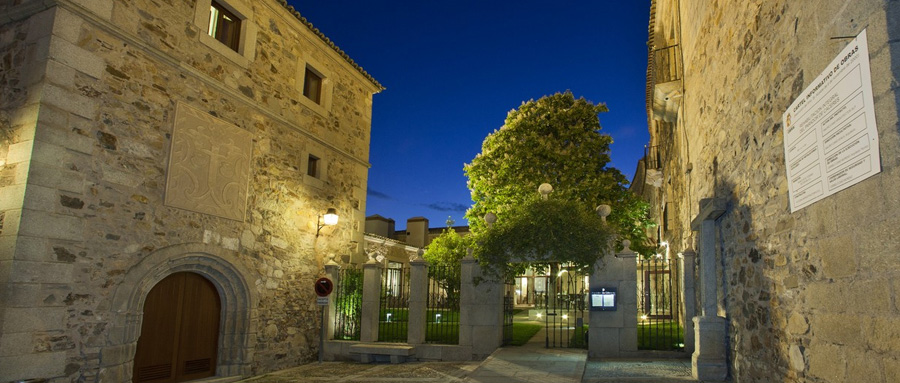
The Parador de Cáceres represents the harmonious union of the palaces of the marquises of Torreorgaz and the so-called Ovando Mogollón, Perero y Paredes House, both dating from the 14th century.
The interior of the building boasts all the elegance, quality and comfort of a historic structure adapted to suit the needs of today's guests, especially the restaurant and outdoor areas, café and guest lounge. This last room is a particularly pleasant spot to meet and chat.
In short, the renovated Parador de Cáceres will set the standard for tourism and gastronomy in the region as both a tourist location and a venue for celebrations and events.
10. PARADOR DE NERJA – Málaga ****
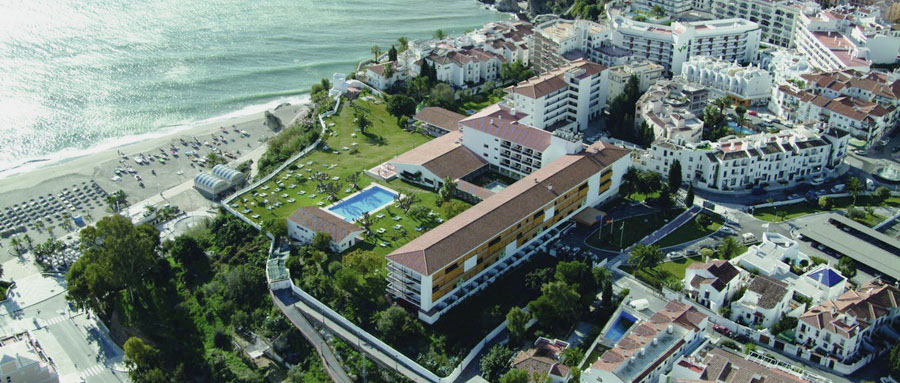
The Hotel is on a cliff overlooking the sea, in an ideal spot to enjoy the beach, which is reached by a singular lift; the coastline and the lovely natural landscape of the area. The entrance to the building boasts a splendid garden whose greenery contrasts with the blue of the pool.
The spacious, light-filled interiors are comfortably furnished with elegant decorative details. All the rooms in the hotel have large terraces looking onto the sea (except basic rooms). The upper rooms also enjoy spectacular views over the Mediterranean and the mountains of the Sierra Almijara, and the beautiful cliffs of this rustic Málaga coast.